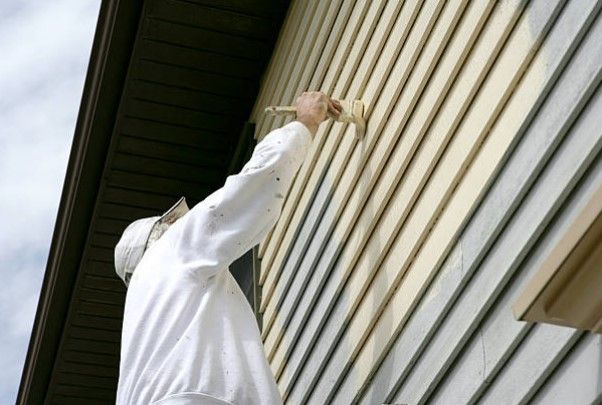How To Select the Perfect Color Scheme: Tips from House Painters
Choosing a colour for just one room can already be challenging. However, selecting a colour palette for your entire house can feel overwhelming. If you coordinate your colours too much, everything will look too similar. On the other hand, if you don't coordinate your colours enough, it will look tacky.
But don't worry! There are ways to pick colours you will love and increase your home's value. Here are the shared tips on successfully choosing colours for your home.

4 House Painters' Tips for Interior Color Scheme Selection
Colour greatly impacts a room's overall design and can completely change its atmosphere. And choosing the perfect paint colour for your home can feel overwhelming since so many options are available. Follow these steps to gain confidence in choosing your home’s perfect paint colour.
1. Discover the Perfect Color Scheme for Your Home's Furniture
While countless paint chips can be available, the paint spectrum consists of only seven colours: red, orange, yellow, green, blue, indigo, and violet.
Here’s what you need to do to create a harmonious
colour
scheme. Begin by selecting three colours from an item in your home: a pillow from the family-room sofa, a favourite tie or scarf, or an expressive painting. Take this object to the paint store and find sample strips that feature these colours. This will give you 15 to 18 usable colours since each strip typically contains six paint colours.
Next, choose one of the three paint colours as the main wall colour and save the other two for use in fabrics or furnishings throughout the room. You can select another colour from the original three sample strips for adjacent rooms.
Lastly, pick a fourth colour that can serve as an accent. Incorporate this colour in small touches throughout each room, whether through pillows, plates, or artwork. This helps establish a connection between the different spaces of your home.
2. Choose the Right Finish for an Attractive Visual Impact
Once you've finalized your colours, it's important to consider the finish you'll be using. Traditionally, satin finishes were believed to be ideal for walls because they are easy to clean and don't highlight imperfections. Semi-gloss and high-gloss finishes were typically reserved for trim to enhance the curves of mouldings or the panels of doors.
Nowadays, finishes create interesting visual effects on entire walls. For example, you can paint one wall with a flat or satin finish and the adjacent wall with a semi-gloss finish in the same colour. When light hits the walls, it creates a corduroy or velvet-like effect.
Similarly, painting the walls with a flat finish and the ceiling with a semi-gloss finish can contrast with a matte and shiny appearance. Remember that higher gloss levels draw more attention to the surface. You may draw attention to the best elements of your home by carefully balancing colour and gloss.
3. Choose Colors that Reflect the Desired Mood in the Room
Colours have the power to evoke specific emotions. Generally, cool colours such as blues, greens, and clean whites create a peaceful and relaxing atmosphere, while warm colours like red, orange, and yellow add drama and energy. Cool colours work well in private rooms, providing a calming effect, while warm colours are great for social spaces, adding vibrancy.
Select colours based on the room's purpose and the desired mood you want to create. For social rooms like dining areas, kitchens, and living spaces, warm colours like daffodil-yellow, coral, or cranberry can be chosen. For private rooms such as home offices, powder rooms, and bedrooms, cooler hues like sage green, violet, or sky blue are recommended.
It's important to note that the emotional impact of colours can vary from person to person. What would feel inviting and welcoming to one person could be off-putting to another. For example, red can increase both appetite and blood pressure. Blues and greens create a natural and calming ambience. Children often like purple, but adults may not prefer it. Yellow is considered inviting, while orange can be welcoming but slightly irritating, depending on the shade.
Yellow can stimulate the brain, so it can be suitable for rooms where homework or work is done. However, it's best to avoid yellow in bedrooms, where the goal is usually to create a relaxing atmosphere. Instead, explore calming colours for the bedroom to help promote better sleep.
4. Understand Different Types of White Paint
White paint has many options. There are pure, "clean" whites with no tinted undertones. These are often preferred by designers who want to highlight artwork or furniture and are commonly used on ceilings to create a neutral overhead space.
Other white paints have either warm undertones, such as yellow, rust, pink, or brown, or cool undertones, like green, blue, or grey. Warm whites are suitable for rooms with little natural light or to create a cozy feel in larger spaces.
On the other hand, cool whites can help make a space appear more open. To determine which white works best with the other colours in the room, it's a good idea to test several options simultaneously.
Avoid These Common Mistakes When Choosing Paint Colors
- Being afraid to explore different paint colour options. Overcome the fear of making a mistake by starting with a colour you love, like one from a rug or painting. Test it on the wall; if it's too strong, ask the paint store to adjust it to a lighter shade or tone it down with more grey.
- Using intense colours on the walls if you have a room with a vibrant oriental rug or other strong-coloured elements. Let those pieces be the focal point, and choose lighter colours for the walls.
- Skimping on paint for the walls. Follow the 60-30-10 rule used by designers, where 60% of the colour comes from the walls, 30% from upholstery or floor coverings, and 10% from accents and artwork. Add some liveliness to those plain white walls.
- Relying solely on paint chip strips. Paint a large piece of foam-core board with the colour and move it around the room for a few days to see how it looks under different lighting conditions. Paint a 4-by-4-foot swatch on the wall and live with it for at least 24 to 48 hours to observe its effects in action.
Forgetting to use primer when changing wall colours. Primer, whether white or tinted, is essential to achieve your chosen true colour and prevent interference from the previous wall colour.

Get House Paint Service from the Finest House Painting Company
Applying the perfect colour scheme for your home becomes easier when you follow the advice from professional house painters. You can create a colour scheme that enhances your home's visual appeal and showcases your style.
Ready to give your home a makeover with a fresh coat of paint? Look no further than Fraser Canyon Painting! Our team of skilled
house painters is experienced in interior and exterior painting, and we're here to breathe new life into your space. Don't wait any longer—contact Fraser Canyon Painting today for a complimentary consultation. Let us help you achieve the home look you've always dreamed of!
FAQs
-
How Much Does a Painter Charge?
The price of hiring a painter can vary based on their experience, location, and the complexity of the project. Painters can charge by the hour or give a fixed quote for the whole project. The typical cost for a painter's labour is between $22 and $43 per hour, excluding taxes and additional expenses. It's important to note that this refers to the hourly wage for hiring a professional painter as an employee.
-
How Much Does Painting Cost?
The total cost of a house can vary depending on factors like the house's size, the number of rooms being painted, the type of paint used, the condition of the walls, and any additional services needed. Painting a regular-sized living room will typically range from $900 to $2,000. Similarly, painting a kitchen or a bedroom will have a similar price range, usually between $300 and $750. For an average-sized bathroom, the expected cost is between $150 and $300.
-
How Much Does It Cost To Paint a House?
The cost of painting a house depends on various factors, including the house's size, the number of floors, the condition of the surfaces, and the type of paint chosen. If you need to paint the inside of a home, the cost typically comes to around $3.50 for every square foot. For example, painting a 1,000-square-foot home would cost $3,500, a 2,000-square-foot home would cost $7,000, and a 3,000-square-foot home would cost $10,500.
-
How Much Does It Cost To Paint the Interior of a House?
The cost of painting the interior of a house is influenced by factors like the house's size, the number of rooms, the height of the ceilings, the condition of the walls, and any additional features such as trim or accent walls. On average, interior painting costs can range from $1,000 to $5,000 or more for an average-sized home.
-
How Much Does It Cost To Paint the Exterior of a House?
On average, it will cost around $5,200 to paint the outside of a 2,000-square-foot home. However, for a three-story house, the cost can range from $5,000 to $12,000. Whether your home has one, two, or three stories, the typical price for an outdoor painting is between $1 and $4 for each square foot.
MENU
GET IN TOUCH
604-239-7881
10070 Brentwood Dr, Chilliwack, BC V2P 6G3
info@frasercanyonpainting.com
Chilliwack, Abbotsford, Maple Ridge, Mission & Hope, BC
GET CONNECTED
Contact Us today!
Contact Us
We will get back to you as soon as possible
Please try again later
Fraser Canyon Painting © 2022 | All Rights Reserved
